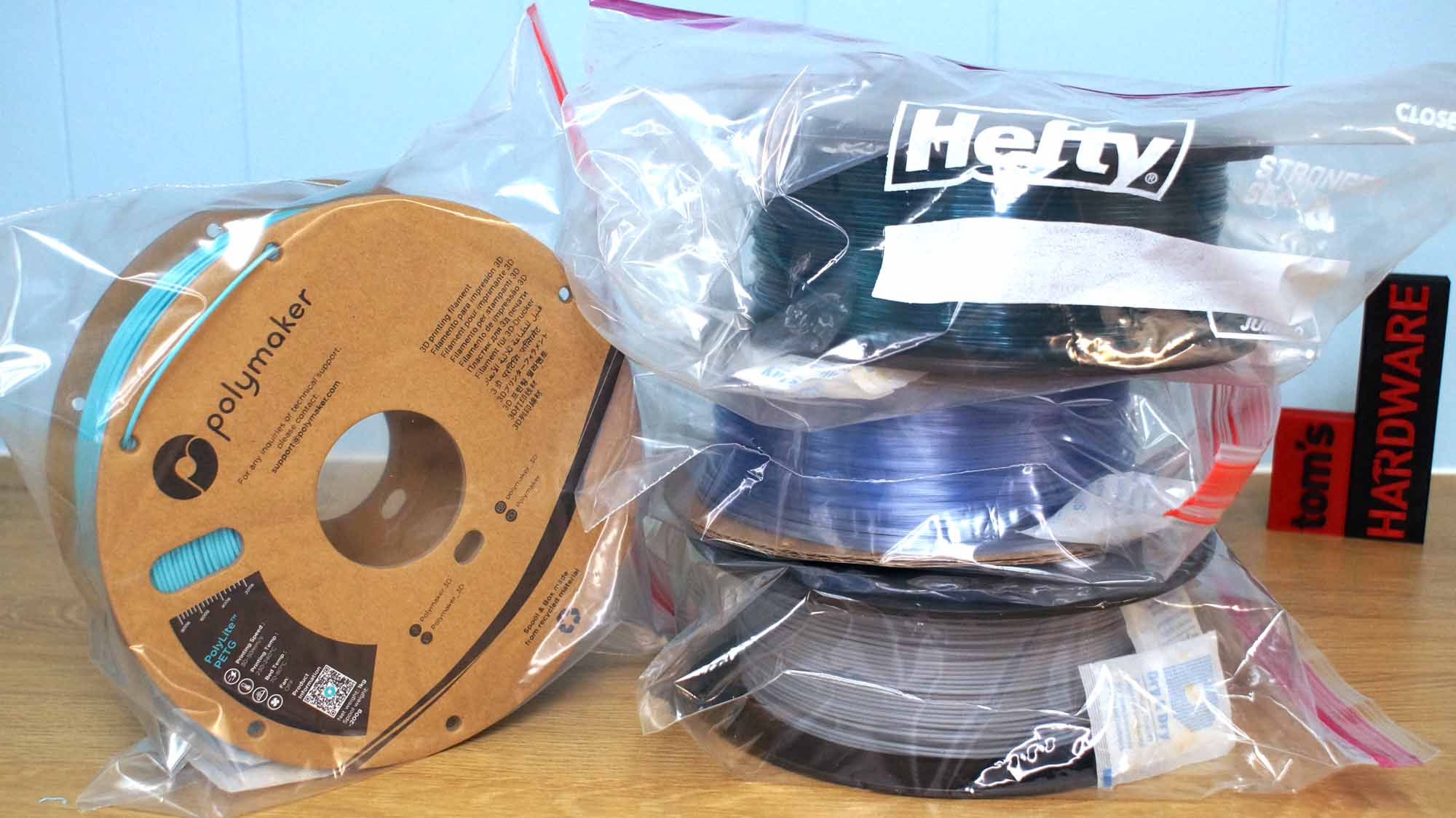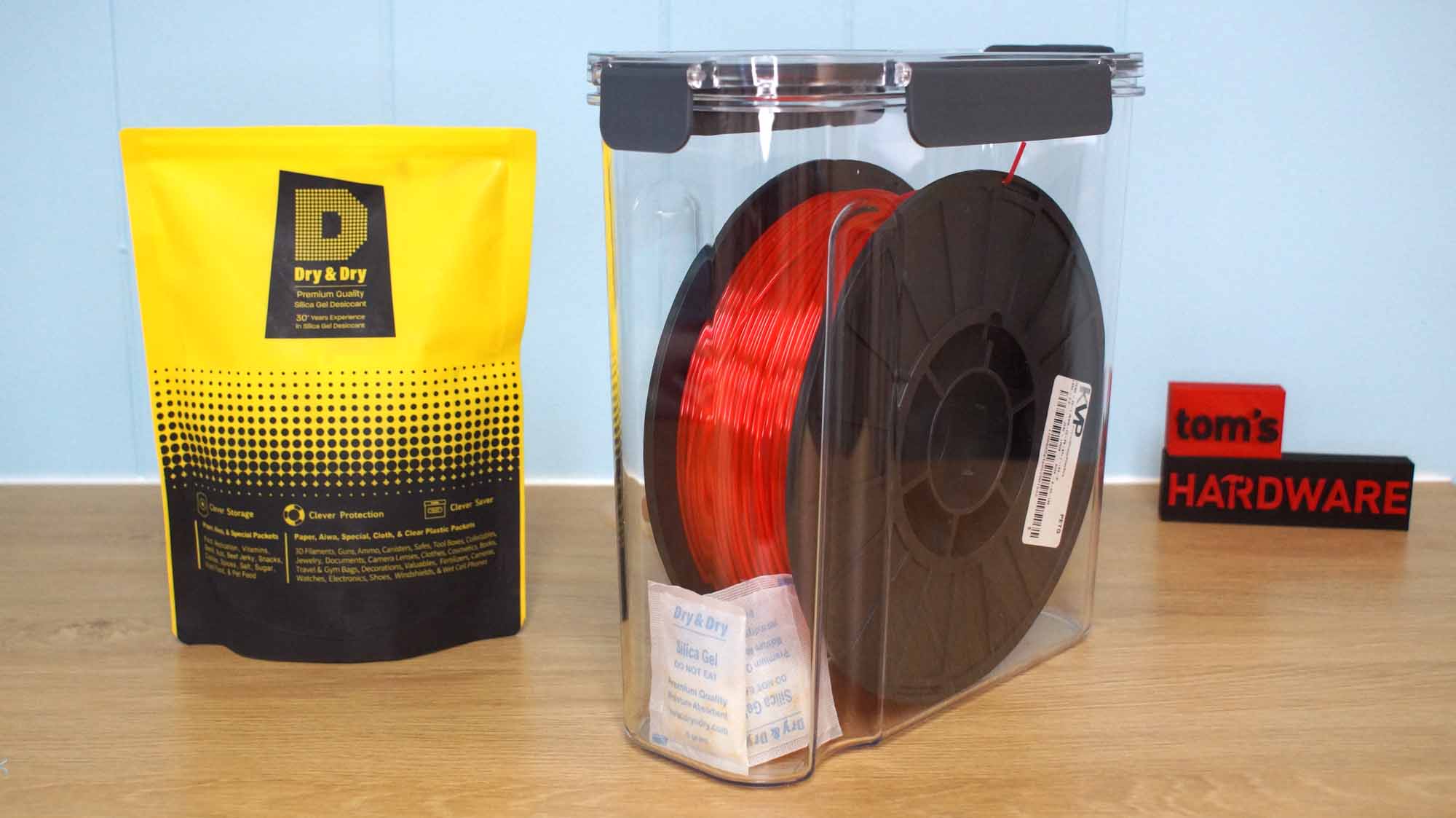How to Store 3D Printer Filament and Keep it Dry
Keep moisture at bay with these handy tips.

Storing filament for your 3D printer is a very personal matter. Some people like to display unwrapped rolls like books on a shelf, while others keep their stock locked away in moisture controlled Tupperware. Which is right?
Both, actually.
If you only print with PLA, store it in a low humidity environment and move through your stock rather quickly, keeping your rolls unwrapped is fine. But if your workshop is in a garage – or you work with more advanced filaments like TPU and nylon – moisture will become a problem.
Why Moist Filament is a Problem
It defies logic, but filament that has absorbed moisture can get brittle, bubbly or stringy. In extreme cases, it will steam and hiss as the filament is heated. Check out this short video from Maker’s Muse who was printing PLA during a record rainy Australian summer.
Given enough time, moisture will eventually seep into PLA. For example, this roll of yellow PLA was left unwrapped for about 6 months and is now stringy.
All 3D printing filaments are created from blends of hygroscopic polymers that are capable of trapping moisture. This leads to brittleness, stringing and failed prints. However, some types of filament are less susceptible to water damage than others. PLA is fairly resistant to moisture and may print perfectly fine after years in the open air, provided that it’s being stored in a room with fairly dry conditions.
Nylon, TPU and even PETG are an entirely different matter. When some of these filaments are left unwrapped for even 24 hours, they can pick up enough moisture to cause a failure.
Get Tom's Hardware's best news and in-depth reviews, straight to your inbox.
Below, we’ll show you several ways to keep your filament safe and organized. We also have instructions on how to dry out filament that’s absorbed moisture so you can use it again effectively.
Shelves for Open Filament Storage
If you want to display your filament out in the open, and don’t mind risking moisture damage, you’ll need to buy sturdy shelving that can handle the load. One option is a custom-made wall rack, like this one from RepKord. The design is free to download from PrusaPrints.org and is made of 3D printed or laser cut parts and metal conduit pipe available at any hardware store.
The rack cradles spools between two lengths of pipe to prevent them from rolling. It can be made as long as you like to hold any amount of filament.
Courtney Blum from Filament Stories goes one step further with a filament bunker. She converted a basement closet into a climate controlled storage unit for over 500 rolls of assorted filament, all organized by color. A dehumidifier constantly pulls moisture from the room, and hygrometers on the shelves let her know that every spool is cozy and dry. Tension rods keep the spools from rolling off the shelving.
Fight Filament Moisture with Desiccant
Desiccant is a drying agent that attracts and traps moisture. Silica gel is a common desiccant you’ll find tucked inside boxes of filament, electronics and just about any product that needs to stay dry during shipping.
You can reuse desiccant packs that shipped with your filament, but I would suggest trying color changing Dry & Dry. Each pack contains color changing beads to let you know when the silica is moist and needs to be dried out again.
I opened a pack of Dry & Dry and exposed half of it to water to show the color beads at work. The yellow beads are dry, the dark green beads are wet.
Silica gel can be dried in the oven and used over and over again. Simply place the packets on a cookie sheet and bake at 200°F for 30 minutes to 2 hours.
One gram of Dry & Dry can protect 120 cubic inches, so a cereal box sized container would only need 3 grams to keep it dry.
Five DIY Containers for Filament Storage
- Method 1: Keep filament in the original package.
If you’re lucky, your filament came in a resealable bag, so check both ends for a zip lock before randomly hacking the package open. When you’re done, return the spool to its original bag with a fresh silica pack.
- Method 2: Use ordinary kitchen zip bags.
Many rolls– especially those on cardboard spools– will fit in a one gallon zip lock food storage bag. Don’t use the one’s with sliders, the opening isn’t wide enough. Thick plastic 1KG spools may need a larger “jumbo” bag.
- Method 3: Keep spools in plastic cereal boxes.
Cereal boxes are designed to keep moisture out, so they’re perfect for holding single spools. It’s a more expensive option than plastic bags, but if you want your shelf to look fabulous – and can afford the extra $8-10 a box for storage – this is a great looking option.
This 18.5 cup box I found at Walmart is wide enough to hold a full 1KG spool. If you’re ready for a little DIY, you can add a spool holder and PTFE connector to use this as a dry box while you print.
- Method 4: Use vacuum bags to reseal filament.
When you really want to keep the moisture out, vacuum seal your spools.
eSun makes a complete vacuum sealing kit for filament. It comes with thick plastic zip bags equipped with a valve and a hand pump for removing air. You get enough bags, silica gel packs and humidity monitoring cards to seal 15 spools.
- Method 5: Plastic tubs for mass storage.
Cheaper than individual boxes, a large storage box with a gasket can keep several spools dry. Large tubs are great for storing filament in closets, garage shelving or stuck in the corner of your workshop.
This 72 quart tub held 16 full 1KG spools, making it a bit awkward to carry.
Dry Out Damaged Filament
Moisture damaged filament can be saved with a little help from a drier. Some sources suggest using your kitchen oven. However not all ovens can maintain the proper temperature and risks melting your entire roll.
DIY Filament Dryer
Taulman3D posted directions for a great DIY dryer made from a 5 gallon bucket, a trouble light and dowel rods. Holes are drilled into the bucket for the rods, ventilation and cord access. The company uses this bucket hack in its own lab and say it can dry two spools overnight.
Buy a Filament Dryer
You can purchase a ready-made dryer from several sources online. I own the Sunlu FilaDryer S1, which can dry one roll at a time in about 6 hours. The Sunlu dryer has a temperature range from 35c to 55c, which isn’t hot enough for nylon, but can handle most hobby-level filaments.
If you need to dry nylon filament, try the Print Dry Pro, which reaches 75c.
Drying Times for Common Filaments
| PLA | 50c | >3 hours |
| PETG | 50c | >3 hours |
| ABS | 55c | >3 hours |
| TPU | 55c | >4 hours |
| ASA | 55c | >4 hours |
| Nylon | 75c | >12 hours |
Desiccants can be dried at 65c for at least 3 hours.
Professional Filament Storage Option

If you want something more classy than a tote box, there’s the RepBox. It can hold six 1kg spools (or 12 half kg spools) in a sealed case that sits next to, underneath, or hung on the wall above your printer.
The RepBox has individual holes for each spool to feed through, allowing you to print directly from the sealed box. It’s also a popular option for tangle free Multi Material printing. Starting at a pricey $149, boxes come in wood finishes, clear acrylic and can be customized with your logo.

Denise Bertacchi is a Contributing Writer for Tom’s Hardware US, covering 3D printing. Denise has been crafting with PCs since she discovered Print Shop had clip art on her Apple IIe. She loves reviewing 3D printers because she can mix all her passions: printing, photography, and writing.
-
LolaGT Set bed temp to 55C, lay roll of filament on bed, place glass bowl over roll, wait three hours(PLA).Reply
If you have a printer, you have a built in dryer.
It is easier to keep it dry by not leaving it in the open, then you don't have to use your dryer very often. -
TacMonkey Reply
Very concise and comprehensive article. Just need to address the use of mixed units; the text contains liberal references to both imperial and SI units, even when the subject described is the same. Might be a silly thing to remark, ut would it not be better to pick one and stick to it, here its either inches or millimetres, farenheit or celcius, etc. Rather just stick to one.. or even better use both if needed.Admin said:6 storage solutions to keep moisture from ruining your precious stock.
How to Store 3D Printer Filament and Keep it Dry : Read more









